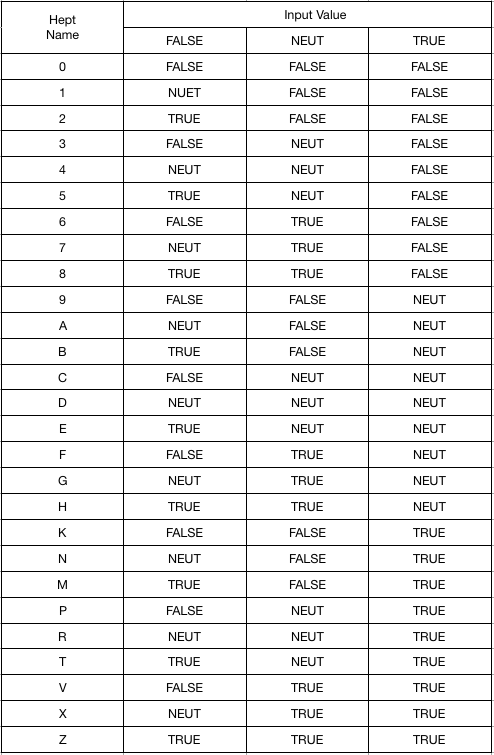In a recent post I introduced the Kleene data type as an addition to the boolean data type. In my hypothetical system both data types are available and bools would continue to operate exactly as they do now with 0 representing FALSE and 1 representing TRUE. Boolean logic works just fine on its own terms, there's no need to mess with it.
In this post I will explore how existing unary operators would work in a balanced ternary system and what additional unary operators are possible with a three valued system. Specifically, the ones that alter the value of a variable or return logical data about the variable. I will not address special purpose unary operators for casting, indirection, etc. and I will look at bitwise and tritwise operators in a later post.
Here are the most common unary operators and what they do:
x++ increments a numerical variable
x-- decrements a numerical variable
-x returns the negation of the value
+x returns the value
!x returns a boolean TRUE or FALSE value opposite the truth value of the variable
The logical negation operator (!) is the only logical operator on the list. It could be adjusted to return a kleene type instead of a boolean, but I don't think altering the behavior of existing operators is a good idea. The other four are arithmetic operators, not logical ones and would work the same way in a ternary system as they do on a binary one.
In a ternary system though, there are 27 unary logical operators. Of course many would be of little or no use, but all of them should be thoroughly explored. To talk about all these new operators we will need a vocabulary to use. It would be too complicated to figure out symbols for each operation and keep track of them so I will use function-style syntax and each unary operation is assigned its heptavintimal name. To reiterate, here are the heptavintimal (see my earlier post called "counting") values for each single-input gate and their truth tables:

For my immediate purposes in writing these posts I'll use the format "logic_x(variable)" indicating a logical operation as opposed to a tritwise operation with 'x' standing in for the hept name. Using this function/hept syntax, the way to perform a logical inversion on variable x is logic_5(x). When I later take a look at tritwise operators I would use tritwise_5(x) to perform a tritwise inversion on variable x. This formatting is just for clarity and probably wouldn't be well liked.
Applying any of these operations to a kleene would of course do exactly what the truth table above states. At this moment I am of the opinion that applying one to a boolean should cause a compiler error. It's probably best not to try to mix kleenes and booleans. If a boolean is adequate for your purposes, use one and apply existing operators. If the flexibility of a kleene would benefit you, use a kleene and apply the above operators as desired.
Example pseudocode snippets:
kleene x = TRUE
print logic_5(x)
FALSE
kleene x = FALSE
print logic_5(x)
TRUE
kleene x = NEUT
print logic_5(x)
NEUT
The question is what would each one mean when applied to a numerical variable? The conventional NOT operator can be used on numbers and it has the property of treating the number as if it was a boolean. If the number was non-zero, its boolean negation would be FALSE and it returns a 0 value. If the number was zero, its boolean negation would be TRUE and it returns a 1. This behavior should remain unchanged.
Probably the most sensible way to do this is to follow that convention, but because the the 27 unary operators follow Kleene logic, they would return a kleene data type. They would treat negative numbers as FALSE, zero as NEUT and positive numbers as TRUE.
Example pseudocode snippets:
int x = 7
print logic_5(x)
FALSE
int x = -4
print logic_5(x)
TRUE
int x = 0
print logic_5(x)
NEUT
The specific example of the logic_5() logical operator used above could be given its own symbol since it is the ternary equivalent of the boolean ! (NOT) operator and would probably be used fairly often. I would suggest !! for ternary negation which is specifically three-valued to distinguish it from boolean NOT which is only two valued. It would also act differently to boolean NOT when used as an arithmetic operator:
int x = 5
int y = -5
int y = 0
print !x
FALSE //because x is non-zero
print !!x
FALSE //because x is positive
print !y
FALSE //because y is non-zero
print !!y
TRUE //because y is negative
print !z
TRUE //because z is 0 (boolean FALSE)
print !!z
NEUT //because z is 0 (ternary NEUTRAL)
Discussions
Become a Hackaday.io Member
Create an account to leave a comment. Already have an account? Log In.